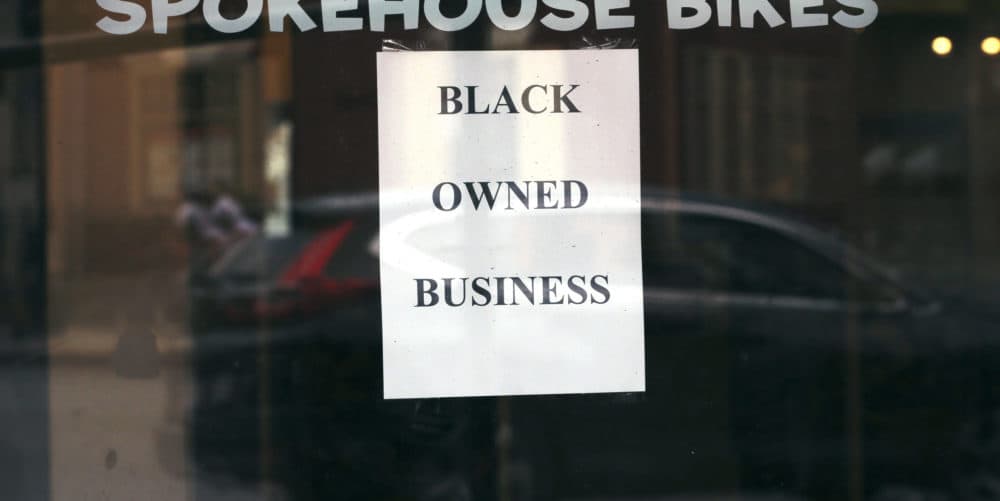Advertisement
Racial Justice Protests Prompt People To Move Their Money Into Black Banks
Resume
Netflix announced it is moving $100 million in deposits into Black-owned financial institutions to help close the racial wealth gap.
As Black Lives Matter protests continue across the U.S., individuals and companies are backing up their words with action by moving their money into Black-owned banks.
Over the past two months, M&F Bank in North Carolina, the nation’s second-oldest Black-owned bank, has seen a “significant uptick” in business from individuals and small to medium-sized businesses, says president and CEO James Sills.
“We've probably seen an increase of close to 20% in overall deposits,” he says. “We're getting minority business customers, white corporations, white customers, Latinos. We're a community bank, and we're seeing support from all segments of the community.”
Initiatives to support Black-owned banks have been going on since the beginning of the Black Lives Matter movement. What’s different about this moment in particular is that “a high percentage” of new accounts are being opened by businesses, Sill says.
“The difference this year with this particular event is there's a greater feeling of responsibility to support businesses and organizations that directly support their communities like our bank,” he says.
The number of Black-owned banks is at its lowest level in history, according to data from the Federal Deposit Insurance Corporation. Their assets keep growing, but they only make up a small amount of the entire U.S. banking industry’s $20.1 trillion in assets.

When you compare Black-owned banks to others, the difference in assets is astounding. M&F Bank manages about $264 million in assets. The country’s largest Black-owned bank, One United, manages about $650 million. By contrast, Wells Fargo manages $1.9 trillion in assets.
The wealth gap between white and Black families is in part connected to this disparity in the banks themselves, Sills says. The average white family’s net worth is nearly 10 times more than the average Black family, according to the Brookings Institution.
“Additionally, there are so many business owners that have been in business for significant periods of time, and they've been able to generate wealth over many, many years,” he says. “And that's really contributing to the wealth gap because some of those other businesses have other means in terms of access to capital that minority firms do not have.”
Part of the problem is Black families are far less likely to use a bank due to the consequences of structural racism in the financial sector. But working with a bank is critical for minorities because people can take advantage of services, such as mortgage and business loans, that help grow wealth, Sills says.
The decision by Netflix is a start, but more needs to be done to close the racial wealth gap in this country, Sills says. He expects other large corporations to follow Netflix’s lead.
“We definitely would leverage those deposits in our institution to redeploy those funds back in the form of loans back into the communities we serve,” he says. “But in addition to deposits, we need to be able to provide services to those kinds of corporations so we can actually generate some additional income.”
Some critics say that supporting Black-owned banks will not solve financial inequality because Black banks are just like any other bank: They prop up capitalism, which has historically left Black people behind.
But Sills argues that Black-owned banks are necessary to help Black people grow their wealth. He points to the Paycheck Protection Program [PPP] as one success.
“If you were to examine the statistics of the PPP loan program, 75% of our loans went to people of color,” he says. “If we had more Black-owned banks, more African Americans, more minorities would have probably been able to participate in that program.”
M&F Bank primarily manages three market segments — small and medium-sized businesses, nonprofit organizations and churches, he says.
With the PPP, “we were able to lend money to those three different market segments, and we actually impacted about 1,300 jobs by providing about $14 million in funding to those customers. And we did loans as low as $500 and as high as $2.6 million,” he says.
Black-owned banks tend to gravitate toward church loans because of their low-risk profile, Sills says. M&F has diversified its portfolio of customers by making more loans to small and medium-sized businesses, which will help the bank survive the current economic downturn that Sills expects will be “three times as worse as the 2008 financial crisis.”
Sills is calling on lawmakers to provide more support to minority-owned financial institutions during the pandemic. He says this is critical to the goal of promoting financial opportunity for minorities.
“If the government could further provide funding to banks like ours, we're a community development financial institution, and so if they could provide funding to the [Community Development Financial Institutions Fund],” he says, “that would really help institutions like ours because we're serving underserved communities.”
Thinking about moving your money into a Black-owned bank? Click here for a map of Black banks and credit unions in the U.S. Have you already moved your money? Tell us about it by emailing letters@hereandnow.org.
Francesca Paris produced and edited this interview for broadcast with Tinku Ray. Samantha Raphelson adapted it for the web.
This segment aired on July 16, 2020.

